本教程演示了 Microsoft Fabric 中 Synapse 数据科学工作流的端到端示例。 在此方案中,我们在 R 中生成欺诈检测模型,并使用基于历史数据训练的机器学习算法。 然后,我们使用模型来检测未来的欺诈交易。
本教程介绍以下步骤:
- 安装自定义库
- 加载数据
- 通过探索性数据分析了解和处理数据,并显示 Fabric Data Wrangler 功能的用法
- 使用 LightGBM 训练机器学习模型
- 使用机器学习模型进行评分和预测
先决条件
获取 Microsoft Fabric 订阅。 或者,注册免费的 Microsoft Fabric 试用版。
登录 Microsoft Fabric。
使用主页左下侧的体验切换器切换到 Fabric。
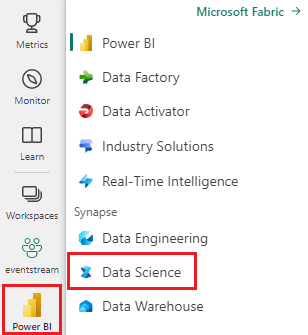
- 如有必要,请创建 Microsoft Fabric 湖屋,如在 Microsoft Fabric 中创建湖屋中所述。
在笔记本中继续操作
可以选择以下选项之一以在笔记中继续操作:
- 在 Synapse Data Science 体验中打开并运行内置笔记本
- 将笔记本从 GitHub 上传到 Synapse 数据科学体验
打开内置笔记本
本教程随附欺诈检测示例笔记本。
若要打开本教程的示例笔记本,请按照 为数据科学教程准备系统中的说明进行操作。
在开始运行代码之前,请务必将湖屋附加到笔记本。
从 GitHub 导入笔记本
本教程随附 AIsample - R Fraud Detection.ipynb 笔记本。
若要打开本教程随附的笔记本,请按照 为数据科学教程准备系统 中的说明将笔记本导入工作区。
如果要复制并粘贴此页面中的代码,可以 创建新的笔记本。
在开始运行代码之前,请务必将湖屋附加到笔记本。
步骤 1:安装自定义库
对于机器学习模型开发或即席数据分析,可能需要为 Apache Spark 会话快速安装自定义库。 有两个选项可用于安装库。
- 请使用内联安装资源(例如
install.packages和devtools::install_version)进行安装,仅限于当前笔记本。 - 或者,可以创建 Fabric 环境、从公共源安装库或将自定义库上传到该环境,然后工作区管理员可以将环境附加为工作区的默认值。 然后,环境中的所有库将可用于工作区中的任何笔记本和 Spark 任务定义。 有关环境的详细信息,请参阅 在 Microsoft Fabric中创建、配置和使用环境。
在本教程中,使用 install.version() 安装不平衡学习库:
# Install dependencies
devtools::install_version("bnlearn", version = "4.8")
# Install imbalance for SMOTE
devtools::install_version("imbalance", version = "1.0.2.1")
步骤 2:加载数据
欺诈检测数据集包含 2013 年 9 月的信用卡交易,欧洲持卡人在两天内进行的信用卡交易。 由于应用于原始特征的主体组件分析(PCA)转换,数据集仅包含数值特征。 PCA 转换了除 Time 和 Amount以外的所有功能。 为了保护机密性,我们无法提供有关数据集的原始功能或更多背景信息。
这些详细信息描述了数据集:
V1、V2、V3...、V28功能是使用 PCA 获取的主要组件Time特性包含一次交易与数据集中第一次交易之间所经过的秒数Amount特征是交易金额。 可以使用此功能进行依赖于示例的成本敏感型学习Class列是响应(目标)变量。 欺诈时其值为1,否则为0
在总计284,807笔交易中,只有492笔交易是欺诈性的。 该数据集高度不平衡,因为少数(欺诈)类仅占数据的约 0.172%。
下表显示了 creditcard.csv 数据的预览:
| 时间 | V1 | V2 | V3 | V4 | V5 | V6 | V7 | V8 | V9 | V10 | V11 | V12 | V13 | V14 | V15 | V16 | V17 | V18 | V19 | V20 | V21 | V22 | V23 | V24 | V25 | V26 | V27 | V28 | 金额 | 类 |
|---|---|---|---|---|---|---|---|---|---|---|---|---|---|---|---|---|---|---|---|---|---|---|---|---|---|---|---|---|---|---|
| 0 | -1.3598071336738 | -0.0727811733098497 | 2.53634673796914 | 1.37815522427443 | -0.338320769942518 | 0.462387777762292 | 0.239598554061257 | 0.0986979012610507 | 0.363786969611213 | 0.0907941719789316 | -0.551599533260813 | -0.617800855762348 | -0.991389847235408 | -0.311169353699879 | 1.46817697209427 | -0.470400525259478 | 0.207971241929242 | 0.0257905801985591 | 0.403992960255733 | 0.251412098239705 | -0.018306777944153 | 0.277837575558899 | -0.110473910188767 | 0.0669280749146731 | 0.128539358273528 | -0.189114843888824 | 0.133558376740387 | -0.0210530534538215 | 149.62 | "0" |
| 0 | 1.19185711131486 | 0.26615071205963 | 0.16648011335321 | 0.448154078460911 | 0.0600176492822243 | -0.0823608088155687 | -0.0788029833323113 | 0.0851016549148104 | -0.255425128109186 | -0.166974414004614 | 1.61272666105479 | 1.06523531137287 | 0.48909501589608 | -0.143772296441519 | 0.635558093258208 | 0.463917041022171 | -0.114804663102346 | -0.183361270123994 | -0.145783041325259 | -0.0690831352230203 | -0.225775248033138 | -0.638671952771851 | 0.101288021253234 | -0.339846475529127 | 0.167170404418143 | 0.125894532368176 | -0.00898309914322813 | 0.0147241691924927 | 2.69 | "0" |
下载数据集并上传到湖屋
定义这些参数,以便可以将此笔记本用于不同的数据集:
IS_CUSTOM_DATA <- FALSE # If TRUE, the dataset has to be uploaded manually
IS_SAMPLE <- FALSE # If TRUE, use only rows of data for training; otherwise, use all data
SAMPLE_ROWS <- 5000 # If IS_SAMPLE is True, use only this number of rows for training
DATA_ROOT <- "/lakehouse/default"
DATA_FOLDER <- "Files/fraud-detection" # Folder with data files
DATA_FILE <- "creditcard.csv" # Data file name
此代码下载数据集的公开可用版本,然后将其存储在 Fabric Lakehouse 中。
重要
在运行笔记本之前,请务必向笔记本添加湖屋。 否则,将遇到错误。
if (!IS_CUSTOM_DATA) {
# Download data files into a lakehouse if they don't exist
library(httr)
remote_url <- "https://synapseaisolutionsa.blob.core.windows.net/public/Credit_Card_Fraud_Detection"
fname <- "creditcard.csv"
download_path <- file.path(DATA_ROOT, DATA_FOLDER, "raw")
dir.create(download_path, showWarnings = FALSE, recursive = TRUE)
if (!file.exists(file.path(download_path, fname))) {
r <- GET(file.path(remote_url, fname), timeout(30))
writeBin(content(r, "raw"), file.path(download_path, fname))
}
message("Downloaded demo data files into lakehouse.")
}
从湖屋中读取原始日期数据
此代码从湖屋的“文件”一节读取原始数据:
data_df <- read.csv(file.path(DATA_ROOT, DATA_FOLDER, "raw", DATA_FILE))
步骤 3:执行探索性数据分析
使用 display 命令查看数据集的高级统计信息:
display(as.DataFrame(data_df, numPartitions = 3L))
# Print dataset basic information
message(sprintf("records read: %d", nrow(data_df)))
message("Schema:")
str(data_df)
# If IS_SAMPLE is True, use only SAMPLE_ROWS of rows for training
if (IS_SAMPLE) {
data_df = sample_n(data_df, SAMPLE_ROWS)
}
打印数据集中类的分布:
# The distribution of classes in the dataset
message(sprintf("No Frauds %.2f%% of the dataset\n", round(sum(data_df$Class == 0)/nrow(data_df) * 100, 2)))
message(sprintf("Frauds %.2f%% of the dataset\n", round(sum(data_df$Class == 1)/nrow(data_df) * 100, 2)))
此类分布表明,大多数交易都是非欺诈的。 因此,在模型定型之前需要数据预处理,以避免过度拟合。
查看欺诈交易与非欺诈交易的分布情况
通过图表查看欺诈交易与非欺诈交易的分布,以展示数据集中的类别不平衡:
library(ggplot2)
ggplot(data_df, aes(x = factor(Class), fill = factor(Class))) +
geom_bar(stat = "count") +
scale_x_discrete(labels = c("no fraud", "fraud")) +
ggtitle("Class Distributions \n (0: No Fraud || 1: Fraud)") +
theme(plot.title = element_text(size = 10))
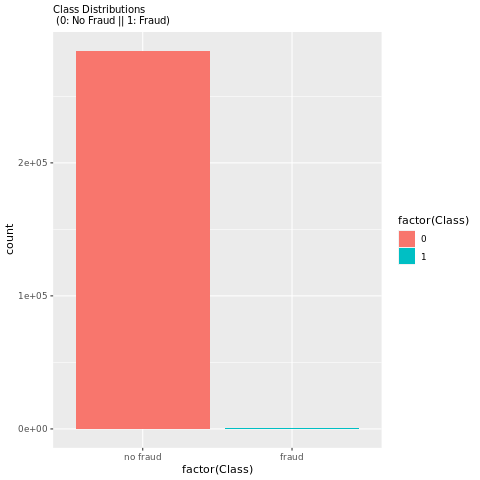
绘图清楚地显示了数据集不平衡:
显示五数字摘要
使用箱形图显示交易金额的五数字摘要(最小值、第一四分位数、中位数、第三四分位数和最大值):
library(ggplot2)
library(dplyr)
ggplot(data_df, aes(x = as.factor(Class), y = Amount, fill = as.factor(Class))) +
geom_boxplot(outlier.shape = NA) +
scale_x_discrete(labels = c("no fraud", "fraud")) +
ggtitle("Boxplot without Outliers") +
coord_cartesian(ylim = quantile(data_df$Amount, c(0.05, 0.95)))

对于高度不平衡的数据,框图可能不会显示准确的见解。 但是,可以先解决 Class 不平衡问题,然后创建相同的绘图,以获取更准确的见解。
步骤 4:训练和评估模型
在这里,你将训练 LightGBM 模型来对欺诈交易进行分类。 在不平衡数据集和均衡数据集上训练 LightGBM 模型。 然后,比较这两个模型的性能。
准备训练和测试数据集
在训练之前,将数据拆分为训练数据集和测试数据集:
# Split the dataset into training and test datasets
set.seed(42)
train_sample_ids <- base::sample(seq_len(nrow(data_df)), size = floor(0.85 * nrow(data_df)))
train_df <- data_df[train_sample_ids, ]
test_df <- data_df[-train_sample_ids, ]
将 SMOTE 应用于训练数据集
不平衡的分类有问题。 对于模型来说,它太少了少数类示例,无法有效地了解决策边界。 合成少数类过度采样技术 (SMOTE) 可以解决此问题。 SMOTE 是合成少数民族类新样本的最广泛使用的方法。 可以使用在步骤 1 中安装的 imbalance 库访问 SMOTE。
仅将 SMOTE 应用于训练数据集,而不是测试数据集。 使用测试数据对模型进行评分时,您需要对模型在未见生产数据上的性能进行一个近似评估。 对于有效的近似值,测试数据依赖于原始不平衡分布来尽可能接近生产数据。
# Apply SMOTE to the training dataset
library(imbalance)
# Print the shape of the original (imbalanced) training dataset
train_y_categ <- train_df %>% select(Class) %>% table
message(
paste0(
"Original dataset shape ",
paste(names(train_y_categ), train_y_categ, sep = ": ", collapse = ", ")
)
)
# Resample the training dataset by using SMOTE
smote_train_df <- train_df %>%
mutate(Class = factor(Class)) %>%
oversample(ratio = 0.99, method = "SMOTE", classAttr = "Class") %>%
mutate(Class = as.integer(as.character(Class)))
# Print the shape of the resampled (balanced) training dataset
smote_train_y_categ <- smote_train_df %>% select(Class) %>% table
message(
paste0(
"Resampled dataset shape ",
paste(names(smote_train_y_categ), smote_train_y_categ, sep = ": ", collapse = ", ")
)
)
有关 SMOTE 的详细信息,请参阅 CRAN 网站上的“imbalance”包和处理不均衡数据集资源。
使用 LightGBM 训练模型
使用不平衡数据集和通过 SMOTE 处理后的均衡数据集来训练 LightGBM 模型。 然后,比较其性能:
# Train LightGBM for both imbalanced and balanced datasets and define the evaluation metrics
library(lightgbm)
# Get the ID of the label column
label_col <- which(names(train_df) == "Class")
# Convert the test dataset for the model
test_mtx <- as.matrix(test_df)
test_x <- test_mtx[, -label_col]
test_y <- test_mtx[, label_col]
# Set up the parameters for training
params <- list(
objective = "binary",
learning_rate = 0.05,
first_metric_only = TRUE
)
# Train for the imbalanced dataset
message("Start training with imbalanced data:")
train_mtx <- as.matrix(train_df)
train_x <- train_mtx[, -label_col]
train_y <- train_mtx[, label_col]
train_data <- lgb.Dataset(train_x, label = train_y)
valid_data <- lgb.Dataset.create.valid(train_data, test_x, label = test_y)
model <- lgb.train(
data = train_data,
params = params,
eval = list("binary_logloss", "auc"),
valids = list(valid = valid_data),
nrounds = 300L
)
# Train for the balanced (via SMOTE) dataset
message("\n\nStart training with balanced data:")
smote_train_mtx <- as.matrix(smote_train_df)
smote_train_x <- smote_train_mtx[, -label_col]
smote_train_y <- smote_train_mtx[, label_col]
smote_train_data <- lgb.Dataset(smote_train_x, label = smote_train_y)
smote_valid_data <- lgb.Dataset.create.valid(smote_train_data, test_x, label = test_y)
smote_model <- lgb.train(
data = smote_train_data,
params = params,
eval = list("binary_logloss", "auc"),
valids = list(valid = smote_valid_data),
nrounds = 300L
)
确定特征重要性
确定在不平衡数据集上训练的模型的特征重要性:
imp <- lgb.importance(model, percentage = TRUE)
ggplot(imp, aes(x = Frequency, y = reorder(Feature, Frequency), fill = Frequency)) +
scale_fill_gradient(low="steelblue", high="tomato") +
geom_bar(stat = "identity") +
geom_text(aes(label = sprintf("%.4f", Frequency)), hjust = -0.1) +
theme(axis.text.x = element_text(angle = 90)) +
xlim(0, max(imp$Frequency) * 1.1)

对于在均衡(通过 SMOTE)数据集上训练的模型,请计算特征重要性:
smote_imp <- lgb.importance(smote_model, percentage = TRUE)
ggplot(smote_imp, aes(x = Frequency, y = reorder(Feature, Frequency), fill = Frequency)) +
geom_bar(stat = "identity") +
scale_fill_gradient(low="steelblue", high="tomato") +
geom_text(aes(label = sprintf("%.4f", Frequency)), hjust = -0.1) +
theme(axis.text.x = element_text(angle = 90)) +
xlim(0, max(smote_imp$Frequency) * 1.1)
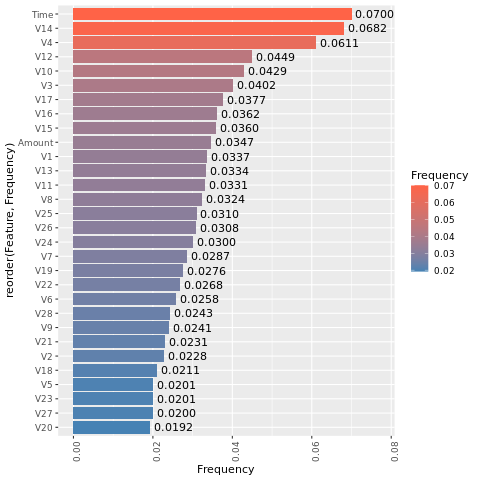
这些绘图的比较清楚地表明,均衡和不平衡的训练数据集具有很大的特征重要性差异。
评估模型
在这里,你将评估两个已训练的模型:
model,使用原始且不均衡的数据进行训练smote_model,使用均衡数据进行训练
preds <- predict(model, test_mtx[, -label_col])
smote_preds <- predict(smote_model, test_mtx[, -label_col])
使用混淆矩阵评估模型性能
混淆矩阵显示以下内容的数量:
- 真正 (TP)
- 真负 (TN)
- 假正 (FP)
- 假负 (FP)
此数量是模型在使用测试数据进行评分时产生的。 对于二元分类,模型返回 2x2 混淆矩阵。 对于多类分类,模型返回 nxn 混淆矩阵,其中 n 是类数。
使用混淆矩阵汇总训练的机器学习模型对测试数据的性能:
plot_cm <- function(preds, refs, title) { library(caret) cm <- confusionMatrix(factor(refs), factor(preds)) cm_table <- as.data.frame(cm$table) cm_table$Prediction <- factor(cm_table$Prediction, levels=rev(levels(cm_table$Prediction))) ggplot(cm_table, aes(Reference, Prediction, fill = Freq)) + geom_tile() + geom_text(aes(label = Freq)) + scale_fill_gradient(low = "white", high = "steelblue", trans = "log") + labs(x = "Prediction", y = "Reference", title = title) + scale_x_discrete(labels=c("0", "1")) + scale_y_discrete(labels=c("1", "0")) + coord_equal() + theme(legend.position = "none") }绘制在不平衡数据集上训练的模型的混淆矩阵:
# The value of the prediction indicates the probability that a transaction is fraud # Use 0.5 as the threshold for fraud/no-fraud transactions plot_cm(ifelse(preds > 0.5, 1, 0), test_df$Class, "Confusion Matrix (Imbalanced dataset)")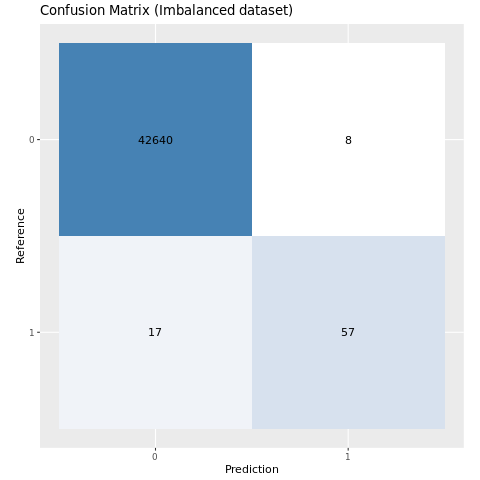
绘制在均衡数据集上训练的模型的混淆矩阵:
plot_cm(ifelse(smote_preds > 0.5, 1, 0), test_df$Class, "Confusion Matrix (Balanced dataset)")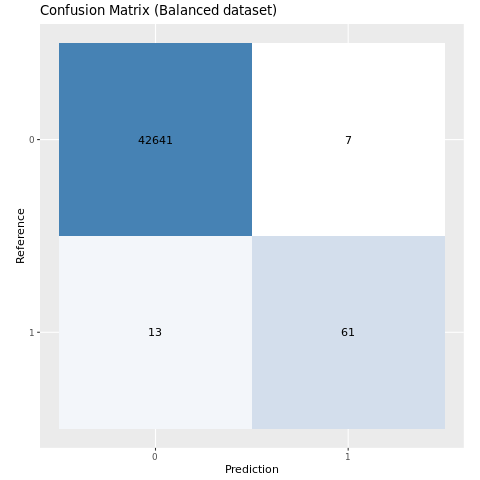
使用 AUC-ROC 和 AUPRC 度量值评估模型性能
接收器操作特征曲线(AUC-ROC)下的面积用于评估二元分类器的性能。 AUC-ROC 图表可视化展示真正阳性率(TPR)与假阳性率(FPR)之间的关系。
在某些情况下,根据“精准率-召回率曲线下面积 (AUPRC)”度量值来评估分类器更为合适。 AUPRC 曲线合并了以下速率:
- 精度或正预测值(PPV)
- 召回率或 TPR
# Use the PRROC package to help calculate and plot AUC-ROC and AUPRC
install.packages("PRROC", quiet = TRUE)
library(PRROC)
计算 AUC-ROC 和 AUPRC 指标
计算并绘制两个模型的 AUC-ROC 和 AUPRC 指标。
不平衡数据集
计算预测:
fg <- preds[test_df$Class == 1]
bg <- preds[test_df$Class == 0]
打印 AUC-ROC 曲线下的面积:
# Compute AUC-ROC
roc <- roc.curve(scores.class0 = fg, scores.class1 = bg, curve = TRUE)
print(roc)
绘制 AUC-ROC 曲线:
# Plot AUC-ROC
plot(roc)

打印 AUPRC 曲线:
# Compute AUPRC
pr <- pr.curve(scores.class0 = fg, scores.class1 = bg, curve = TRUE)
print(pr)
绘制 AUPRC 曲线:
# Plot AUPRC
plot(pr)
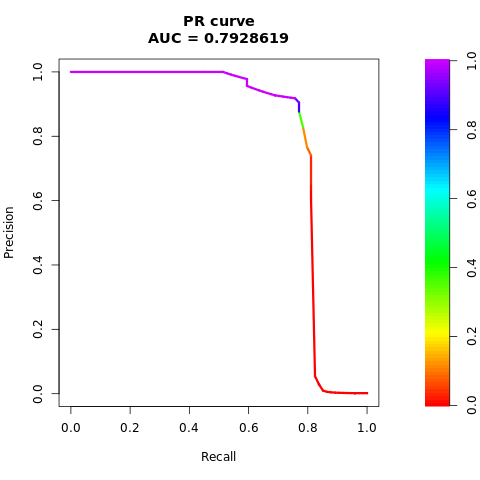
均衡(通过 SMOTE)数据集
计算预测:
smote_fg <- smote_preds[test_df$Class == 1]
smote_bg <- smote_preds[test_df$Class == 0]
打印 AUC-ROC 曲线:
# Compute AUC-ROC
smote_roc <- roc.curve(scores.class0 = smote_fg, scores.class1 = smote_bg, curve = TRUE)
print(smote_roc)
绘制 AUC-ROC 曲线:
# Plot AUC-ROC
plot(smote_roc)

打印 AUPRC 曲线:
# Compute AUPRC
smote_pr <- pr.curve(scores.class0 = smote_fg, scores.class1 = smote_bg, curve = TRUE)
print(smote_pr)
绘制 AUPRC 曲线:
# Plot AUPRC
plot(smote_pr)

先前的数据清楚地表明,在均衡数据集上训练的模型在AUC-ROC和AUPRC分数上均优于在不平衡数据集上训练的模型。 此结果表明,在处理高度不平衡的数据时,SMOTE 可有效地提高模型性能。
相关内容
- Microsoft Fabric 中的 机器学习模型
- 训练机器学习模型
- Microsoft Fabric 中的机器学习试验